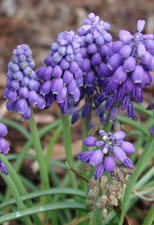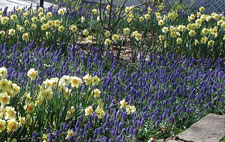Resource Library
Plant of the Week: Hyacinth, Grape
The University of Arkansas System Division of Agriculture does not promote, support or recommend plants featured in "Plant of the Week." Please consult your local Extension office for plants suitable for your region.
Plant of the Week
Grape Hyacinth
Latin: Muscari armeniacum

Gardens are often a kind of controlled chaos. Some gardeners are completely comfortable with the chaos theory of gardening while others reject it; insisting on discipline and order. The former group considers plants like grape hyacinth (Muscari armeniacum) a choice springtime bulb while the latter group thinks of it as a noxious weed.
Grape hyacinths are one of the "minor bulbs" of the bulb trade; so called because they are small in stature, and their sales volume is minute compared to tulips and narcissus. They grow from thumb-sized elongated bulbs that produce offsets freely. In the fall, fleshy, 10-inch long grass-like leaves emerge from the ground and splay out across the ground. If the winter is hard, the foliage will suffer considerably by the time blooms appear in mid spring. By late spring, foliage will disappear.
The typical grape hyacinth form has cobalt blue flowers clustered about the end of the 6-inch long stem. White and pale blue cultivars are also available. The individual florets are urn-shaped with the bottom flowers opening first while those above are smaller and less developed. The bloom cluster is reminiscent of an inverted cluster of Concord grapes. The scapes continue to elongate during the six weeks are in bloom, opening new blooms near the top while those below wither away.
In Frances Burnett’s cherished masterpiece, The Secret Garden, the heroine of the tale discovers emerging bulb sprouts pushing up from neglected flower beds in her hideaway. She enquires of the housemaid to learn if little bulbs will live a long time without special care. The housemaid replies: "They’re things as helps themselves. That’s why poor folks can afford to have ‘em. If you don’t trouble ‘em, most of ‘em’ll work away underground for a lifetime an’ spread out an’ have little ‘uns."

Such is the case with grape hyacinth. They’ll have "little ‘uns" in quantity, forming sprawling drifts of green and purple in unexpected places. Large patches are charming naturalized in the woodland garden, but they can also drift into the lawn. In the lawn their waxy coat protects them from weed killers and they can become a first order pest.
Most of the spread is by reseeding, so pinching off spent scapes before the seeds have a chance to mature can remedy the reseeding problem. If allowed to reseed, new bulbs won’t usually flower till their fourth year.
Grape hyacinths look best when used in mass plantings under large shrubs, mingled amongst daffodils or naturalized in open woods. They do well in average soil conditions in full sun or part shade. They will tolerate wetter wintertime soils than most bulb species, but certainly not boggy sites.
Bulbs are available in the fall with the other spring bulbs. Plant grape hyacinth bulbs four inches apart and 4 or 5 inches deep. Over time, plantings may have fewer flowers. When this happens it may be because there is too much shade or the clumps need dividing. Lift and divide the clumps as the foliage begins to wither, replanting only the largest bulbs.
By: Gerald Klingaman, retired
Extension Horticulturist - Ornamentals
Extension News - April 6, 2007
The University of Arkansas System Division of Agriculture does not maintain lists of retail outlets where these plants can be purchased. Please check your local nursery or other retail outlets to ask about the availability of these plants for your growing area.